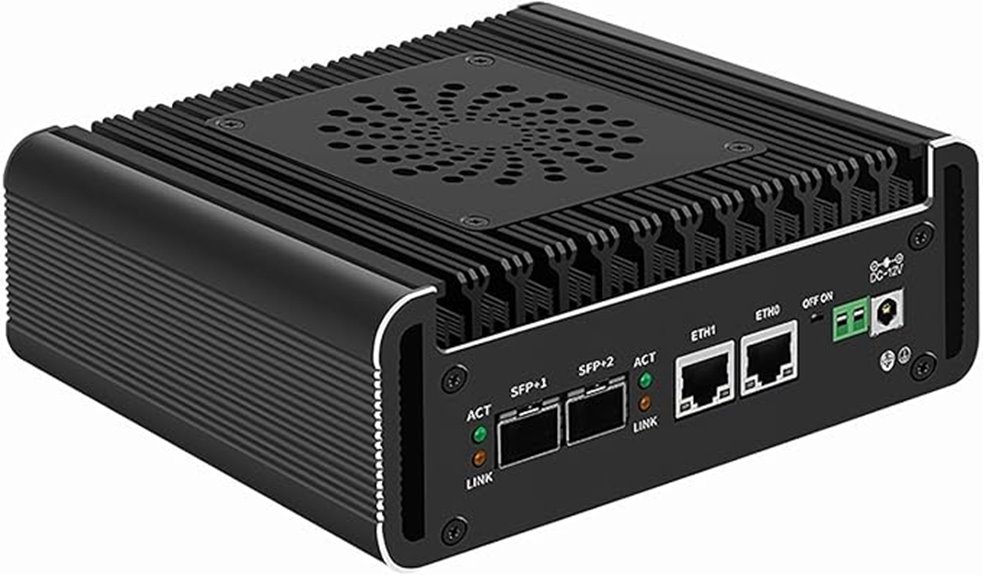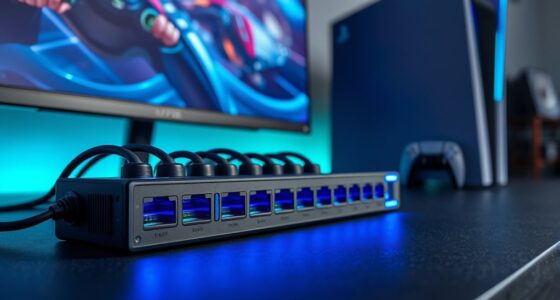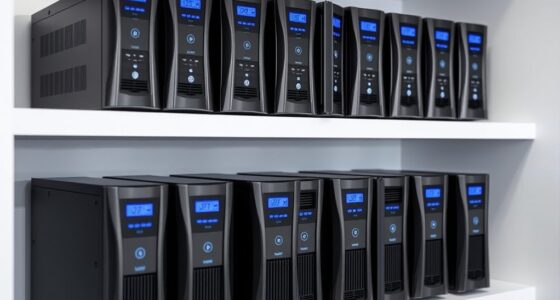Choosing the right UTM firewall in 2025 isn’t just about picking the most popular device. You need solutions that offer high security, easy management, and reliable performance tailored to your network’s needs. With so many options available, it’s essential to understand which features truly matter. Stay with us as we explore the top contenders that can help safeguard your infrastructure while keeping operations smooth and efficient.
Sophos XGS 126 Next-Gen Firewall with Xstream Protection

If you’re seeking a firewall that combines advanced threat prevention with high-speed performance, the Sophos XGS 126 Next-Gen Firewall with Xstream Protection is an excellent choice. It offers comprehensive security tailored for demanding environments, supporting SaaS, SD-WAN, and cloud apps. Its Xstream Protection architecture defends against the latest threats while accelerating network traffic, with firewall throughput reaching 10,500 Mbps. Features like TLS 1.3 decryption, deep packet inspection, and next-gen IPS ensure thorough threat detection. Plus, its easy policy management and extensive security features make it ideal for complex networks demanding both speed and robust protection.
Best For: organizations requiring high-performance, comprehensive network security that supports SaaS, SD-WAN, and cloud applications in demanding environments.
Pros:
- High firewall throughput of 10,500 Mbps ensures fast and reliable performance.
- Advanced threat prevention features like TLS 1.3 decryption and deep packet inspection provide thorough security.
- Easy policy management and extensive security options suit complex network needs.
Cons:
- May be cost-prohibitive for small or less demanding networks.
- Requires some technical expertise to fully leverage advanced security features.
- Physical hardware setup might be complex for users unfamiliar with network appliances.
Firewall Micro Appliance Core N150, Mini PC with 4 LAN, 2x10G SFP+, 2xDDR5, 2xNVMe, USB, Type-C, HDMI

Looking for a compact yet powerful firewall solution that handles high-speed data transmission and complex security tasks? The Firewall Micro Appliance Core N150 is exactly what you need. It features an Intel N150 quad-core CPU, supporting multitasking, with 1 DDR5 slot for fast RAM. Its connectivity options include 2x 10G SFP+ ports and 2.5G LAN ports, ideal for high-speed networks. Storage options support up to three drives, and HDMI, USB, and Type-C ports enable versatile management. Its aluminum case offers excellent heat dissipation, and the flexible cooling system allows silent operation. Perfect for firewall, virtualization, and network security, all in a compact, VESA-mountable design.
Best For: small to medium-sized businesses and tech enthusiasts seeking a compact, high-performance firewall and network security appliance with robust high-speed connectivity and virtualization capabilities.
Pros:
- Supports high-speed data transmission with dual 10G SFP+ ports and 2.5G LAN ports, ideal for demanding network environments
- Compact, VESA-mountable design with excellent heat dissipation and flexible cooling options for silent operation
- Supports virtualization platforms like pfSense, ESXi, and PVE, making it versatile for various network and security tasks
Cons:
- Limited RAM upgrade options with only one DDR5 SODIMM slot, which may constrain heavy multitasking or advanced applications
- Small storage capacity may require additional investment in NVMe or SATA drives for extensive data needs
- The compact size could limit expandability compared to larger enterprise-grade network appliances
HUNSN 1U Firewall Appliance with 10GbE and Intel Core i7-3520M

The HUNSN 1U Firewall Appliance stands out for enterprises needing high-speed, reliable network security, thanks to its dual 10GbE SFP+ ports and robust Intel Core i7 processor. With an industry-grade motherboard, 8GB RAM, and a 64GB SSD, it ensures dependable performance and durability. Its flexible connectivity options include six Gigabit LAN ports, USB, VGA, console, and GPIO, making deployment straightforward. Compatible with pfSense, OPNsense, Linux, and Windows, it offers strong security features with Intel AES instructions. Designed for long-term operation, it combines low power consumption with quiet cooling, ideal for demanding enterprise environments.
Best For: enterprises seeking high-performance, reliable network security with flexible high-speed connectivity and robust hardware for demanding environments.
Pros:
- Supports dual 10GbE SFP+ ports for ultra-fast network throughput
- Compatible with popular open-source firewall solutions like pfSense and OPNsense
- Industry-grade motherboard and components ensure durability and long-term reliability
Cons:
- May require technical expertise for initial setup and configuration
- Limited to 8GB RAM, which might be insufficient for extremely heavy workloads
- Bulkier 1U form factor could be less suitable for space-constrained environments
Factors to Consider When Choosing a UTM Firewall Review
When choosing a UTM firewall, you need to consider its performance capabilities and security features to ensure it meets your needs. Compatibility with your network and ease of management are also key factors to look at. Don’t forget to evaluate hardware reliability to keep your network protected and running smoothly.
Performance Capabilities
Performance capabilities are crucial when selecting a UTM firewall, as they determine how well the device can handle your network’s demands. You should evaluate the firewall throughput to ensure it can manage peak loads without bottlenecks, ideally exceeding 10 Gbps for high-demand environments. Check the IPS and threat protection throughput, so the device can inspect and block threats at line speed without impacting performance. Pay attention to latency metrics, especially for UDP traffic, to keep delay minimal for VoIP or gaming. Also, review the system’s capacity for simultaneous sessions and connections, which supports multiple users and high traffic levels efficiently. Lastly, verify if the device leverages hardware offloading and dedicated processing cores to optimize overall network performance.
Security Features
Are you confident your UTM firewall’s security features can keep up with today’s evolving cyber threats? To ensure robust protection, look for integrated security tools like intrusion prevention, web filtering, and malware scanning that work together seamlessly. Advanced capabilities such as deep packet inspection and SSL/TLS decryption are vital for uncovering threats hidden in encrypted traffic. Real-time threat detection and automated responses help you quickly mitigate attacks, reducing potential damage. Regular updates and threat intelligence integration are essential for staying ahead of new vulnerabilities and attack techniques. Additionally, granular policy management and customizable exception rules give you precise control over network traffic, strengthening your security posture. Prioritizing these features helps safeguard your network against sophisticated cyber threats effectively.
Network Compatibility
Choosing the right UTM firewall requires ensuring it seamlessly integrates with your existing network infrastructure. You need to verify that it supports your current protocols and standards, such as IPv4, IPv6, and VLAN tagging, for smooth operation. Check if the device has compatible ports and interfaces, like Ethernet, SFP+, or fiber, to match your physical connectivity needs. Confirm its compatibility with your network topology, including support for multiple subnets, VPNs, and high-availability setups. It’s also essential to ensure the firewall can integrate with your existing network management and monitoring tools. Finally, assess whether it can handle your network’s bandwidth and traffic load without causing bottlenecks or latency, ensuring reliable performance under your typical network conditions.
Management Ease
A user-friendly management interface is crucial when selecting a UTM firewall, as it directly impacts how easily you can configure policies, monitor activity, and troubleshoot issues. An intuitive interface simplifies administrative tasks and reduces the time spent on complex setups. Centralized dashboards offer real-time alerts and analytics, allowing you to respond swiftly to security events. Automated policy enforcement and updates help maintain a consistent security posture with minimal manual effort. Support for remote management via secure web or mobile portals adds flexibility and boosts operational efficiency. Clear documentation and straightforward controls also help you get up to speed quickly, regardless of your experience level. Overall, a well-designed management interface makes managing your security infrastructure more efficient, reliable, and less prone to errors.
Hardware Reliability
Hardware reliability is the foundation of effective network security, ensuring your UTM firewall remains operational around the clock. To achieve this, choose models built with high-quality components like enterprise-grade motherboards, durable power supplies, and efficient thermal management. These elements reduce the risk of hardware malfunctions and increase longevity. Reliable firewalls typically pass rigorous testing and hold certifications that verify their durability and performance standards. Features like dual power supplies and hot-swappable drives boost system availability by providing fault tolerance and easy maintenance. Regular firmware updates and hardware diagnostics are crucial for maintaining peak performance and catching potential issues early. Prioritizing hardware reliability ensures your network stays protected without unexpected downtime or failures.
Scalability Options
As your network grows, ensuring your UTM firewall can keep pace with increasing demands becomes vital. Scalability options allow you to expand your security infrastructure smoothly, protecting long-term investments. Look for solutions with modular hardware designs or license-based feature upgrades, making it easier to add capacity as needed. The ability to incorporate extra network interfaces like additional Ethernet ports or SFP+ modules is essential for flexible deployment. High throughput capacities—multi-gbps firewall and VPN performance—are critical to handle rising data loads without bottlenecks. Additionally, flexible licensing models and cloud management options enable seamless scaling without extensive hardware replacements or complex reconfigurations. Choosing a UTM firewall with robust scalability ensures your security stays aligned with your expanding network needs, reducing future disruptions and maintaining optimal performance.
Cost Effectiveness
Choosing a cost-effective UTM firewall requires carefully weighing upfront expenses against ongoing operational costs. Start by evaluating the total cost of ownership, including purchase price, maintenance, and support fees, to understand the full financial impact. Consider the performance-to-price ratio, ensuring you get essential security features without paying for unnecessary extras. Analyze licensing and subscription costs for advanced security services, as these can add up over time. Look for solutions that balance features and scalability with your budget to maximize long-term value. Additionally, assess energy consumption and operational expenses; more efficient firewalls can lower energy bills and reduce ongoing costs. By taking these factors into account, you’ll find a solution that offers solid protection without breaking the bank.
Conclusion
In 2025, choosing the right UTM firewall depends on your network needs. Whether you prioritize high throughput with the Sophos XGS 126, need a compact, versatile device like the N150, or require scalable connectivity via the HUNSN Appliance, each offers strong security and reliability. Assess your environment carefully, considering factors like speed, management, and hardware durability. Making the right choice ensures your network stays protected, efficient, and ready for future challenges.








